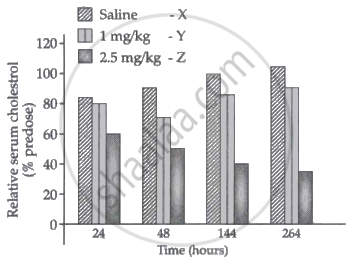Advertisements
Advertisements
Question
What is the major advantage of producing plants by micropropagation?
Solution
Micropropagation - This method of producing thousands of plants by tissue culture is called micropropagation. In this, each plant is genetically identical to the original plant from which they are prepared. These are called somaclones. Most of the important food plants like tomato, banana, apple etc. have been produced on a commercial scale by this method.
This method can prepare thousands of plants in a very short period. Another important application of this method is recovering healthy plants from diseased plants. Although the plant is infected by the virus, the meristem (apical and axillary) remains free of the virus. Hence, the meristem is separated and grown in in vitro culture so that virus-free plants can be prepared. Scientists have succeeded in culturing meristems of banana, sugarcane, potato, etc.
Scientists have even isolated single cells from plants and, after digesting their cell walls, have been able to isolate naked protoplasts (surrounded by plasma membranes). Isolated protoplasts from two different varieties of plants - each having a desirable character – can be fused to get hybrid protoplasts, which can be further grown to form a new plant. These hybrids are called somatic hybrids while the process is called somatic hybridisation.
APPEARS IN
RELATED QUESTIONS
Which part of the plant is best suited for making virus-free plants and why?
Crystals of Bt toxin produced by some bacteria do not kill the bacteria themselves because −
How has the use of Agrobacterium as vectors helped in controlling Meloidogyne incognita infestation in tobacco plants? Explain in the correct sequence.
Answer the following question.
Write the desirable characters a farmer looks for in his sugarcane crop.
GM crops especially Bt crops are known to have higher resistance to pest attacks. To substantiate this an experimental study was conducted in 4 different farmlands growing Bt and non Bt-Cotton crops. The farm lands had the same dimensions, fertility and were under similar climatic conditions. The histogram below shows the usage of pesticides on Bt crops and non-Bt crops in these farm lands.

- Which of the above 4 farm lands has successfully applied the concepts of Biotechnology to show better management practices and use of agrochemicals? If you had to cultivate, which crop would you prefer (Bt or Non- Bt) and why?
- Cotton Bollworms were introduced in another experimental study on the above farm lands wherein no pesticide was used. Explain what effect would a Bt and Non Bt crop have on the pest.
Cry-genes have been introduced in:
A cell swells up when kept in:
At what temperature milk gets pasteurised?
A protoxin is ______.
Assertion (A): In Bt cotton, B. thuringiensis produces a toxic insecticidal crystalline protein which destroys bollworms.
Reason (R): B. thuringiensis produces this toxic protein in an inactive form, but when an insect ingests this inactive protein, it is converted into active form of toxin due to the alkaline pH of gut which solubilises the crystals, which is responsible for the death of bollworm.
Tobacco plants resistant to a nematode have been developed by the introduction of DNA that produces (in the host cells).
Many proteins are secreted in their inactive form. This is also true of many toxic proteins produced by microorganisms. Explain how the mechanism is useful for the organism producing the toxin?
Gene expression can be controlled with the help of RNA. Explain the method with an example.
What are the various advantages of using genetically modified plants to increase the overall yield of the crop?
|
RNA interference (RNAi) holds great potential as a therapeutic agent for the treatment of human diseases and as biocontrol agents in controlling pests in the field agriculture. An experiment was carried to study the use of 'RNAi' for the potential treatment of disorders of cholesterol metabolism. Some people possess genetic mutations with elevated levels of ApoB gene which predisposes them to coronary artery diseases. Lowering the amount ApoB can reduce the number of lipoproteins and lower the blood cholesterol. Tracy Zimmerman and her colleagues used RNAi in 2006 to reduce the level of ApoB in non human primates Cynomolgus monkeys. One group of monkeys were given RNAi treatment (small interfering RNAs, SiRNAs) (doses 1 mg/kg, SiRNAs), second group of monkeys were given RNAi treatment (doses 2.5 mg/kg, SiRNAs) and third group of monkeys were injected with saline. |
The results of the study are depicted in the graph below:

- How does the treatment with 2.5 mg/kg bring an effect on cholesterol metabolism when compared from 24 hours and 144 hours?
- Write any two natural sources from where dsRNA molecule could be obtained for silencing the specific mRNA.
- How is RNAi used in controlling the infection on the roots of tobacco plants by the nematode Meloidogyne incognitia?
On spraying Bacillus thuringiensis on an infected cotton crop field the pests are killed by the toxin, however the toxin although produced by the bacteria does not affect it. Explain giving reason.
State any two benefits of Genetically modified crops.
Certain specific bacterial spores are mixed in water and sprayed over Brassica crop to control butterfly caterpillars.
Name this bacterium and its mode of action on the butterfly caterpillars.
Compare and contrast the disadvantages of production of genetically modified crops.
